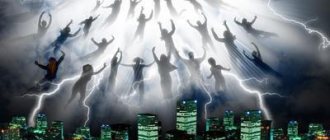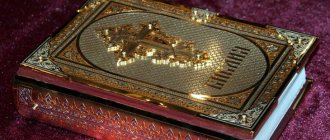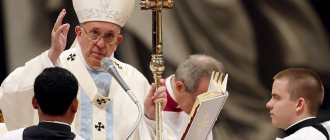Inscriptions on icons – conventional designations and abbreviations adopted in Russian Orthodox iconography.
The inscriptions can be made both in Church Slavonic and in Greek. In icon inscriptions, contracture (Latin contractura - tightening) is widely used - an abbreviated spelling of a word using an initial and final letter. A superscript abbreviation sign is placed above the contractures - titlo (҃)
An abbreviated inscription of the name Jesus Christ, composed of two pairs of letters under the titles:
. The baptismal halo (the so-called cruciform prostration), reminiscent of the Savior’s death on the cross, the redemptive action of which embraces the whole world - “cruciformly, as if by the cross you wished to save the world.” Number 4 is an image of spatial completeness. The four “ends” that make up the cross at the intersection connect the four cardinal directions.
The letters of the Greek word are written on the three visible sides of the halo cross
, which means Jehovah. The technique appears around the 11th century. This inscription emphasizes the Divinity of Jesus Christ, according to the revelation to the former Moses from the bush: “I am who I am” (Ex. 3:14).
In the Russian icon painting tradition, the Greek letter
(omega) is often replaced by the letter (from).
On Greek and Bulgarian icons the letter
(omicron) is located on the left, (omega) is at the top, (nu) is on the right, and the inscription is read in a circle from left to right.
On Russian icons, another letter order is more common: on the left
(about) or (from), above (he), on the right (our). The inscription is read line by line, starting at the top and then from left to right in the second line.
It is worth noting that the biblical explanation of letters in Rus' was not the only one. From Old Believer literature, a different interpretation is known, perhaps somewhat naive, but not violating the dogmatic provisions of the Church. In accordance with it, three letters express, firstly, the trinity of God; secondly, the Deity of Jesus Christ:
(from) - “there are also father marks.” (he) - “oum” (mind), (our) - “incomprehensible”; and, thirdly, the incarnation of the Son of God and His suffering: (from) - “came from heaven”, (he) - “they did not know Me”, (our) - “crucified on the cross.”
As follows from these interpretations, the order of reading letters in Rus' was also not uniform and could change, completely breaking with the Greek tradition and replacing the word “existent” with the abbreviation
.
Inscriptions on icons
The inscriptions on ancient icons were simple. Some well-known words on icons were abbreviated. In addition to Ιησους Χρηστος, Μητηρ Θεου, Αρχαγγελος, ο Δικαιος, ο Προφητης, ο Αγι were also reduced ος and η Αγια, and often before the hieroglyphic sign.
The names on the icons were written clearly legible, but among Saint John (the Forerunner, Chrysostom) both the name (Ιωαννης) and the name Forerunner (ο Προδρομος), Chrysostom (ο Χρυσοστομος) were often significantly abbreviated.
| Greek spelling | Church Slavonic spelling | Translation, transcription |
| Θεος | Bg | God |
| – | Gd | Lord |
| ΙΣ ΧΣ | IС ХС, IIS ХС, IСЪ ХСъ | Greek: abbreviated spelling of the name Ιησουσ Χριστος. Tserkovnoslav.: Jesus Christ |
| ΙΧΘYΣ | – | Literally “fish”, Greek acronym from Ιησουσ Χριστος Θεου Yσιος, Σωτηπ - Jesus Christ the Son of God, Savior |
| ο ων | – | The abbreviated spelling of the name of God is “I am”, “I am who is” - “I am who is” (Ex. 3:14). The inscription of the name of the Holy Trinity on the cross-shaped halo on icons of Jesus Christ |
| – | King of glory | King of Glory |
| ΜΠ ΘY | MN BJN | Greek: abbreviation for Μητερ Θεου. Church Slav.: Mother of God |
| – | 1. B.M. 2. BCA 3. P.B. | 1. Mother of God 2. Mother of God 3. Holy Mother of God |
| – | I. N. Ts. I | An abbreviated inscription on the Crosses, a sign of words written in three languages (Hebrew, Greek and Latin) by Pontius Pilate on a tablet nailed above the head of the Savior: “Jesus of Nazareth, King of the Jews” |
| ΤΚΠΓ | ML RB | Greek: abbreviation for Τουτο Κρανιον Παραδεισος Γεγονε Tserkovnoslav.: Abbreviation for “the place of the forehead was heaven”, or “the place of the forehead was crucified” inscription on the image of the Cross |
| – | GG | Mount Golgotha, inscription at the foot of the image of the Cross |
| – | GA | Head of Adam, inscription on the skull depicted at the foot of the Cross |
| – | TO | The spear is one of the instruments of the passions, depicted at the Cross |
| – | T | Short for “cane” - one of the instruments of the passions, depicted at the Cross |
| – | CT | Abbreviation for “spear” and “reed”, signature of the instruments of the passions on images of the Cross |
| ΑΓΙΟΣ,αγιος | AGIOS, HOLY, STY, STN, STI, ST, ST | Saint |
| ΑΓΙΑ, αγια | AGIA, PACK | Holy |
| ΟΚΑ, ΟΑΚ | – | Righteous |
| – | PRO | Prophet |
| – | APL | Apostle |
| – | STL | Saint |
| – | MC, MCNK | Martyr |
| – | ETC | Reverend |
| Inscription | A country | Translation |
| Pskov. XV century | Jesus Christ | |
| Greece. XVI century | Jesus Christ | |
| Rus. XVI century | Jesus Christ | |
| Byzantium. XIV century | Mother of God | |
| Rus. XVI century | Mother of God | |
| Serbia. XIV century | Mother of God | |
| Byzantium. XII century | Archangel | |
| Greece. XVI century | Archangel | |
| Greece. XVI century | Archangel | |
| Greece. XVI century | Righteous | |
| Greece. XVI century | Righteous | |
| Rus. XV century | Prophet | |
| Greece. XVI century | Prophet | |
| Rus. XV century | Prophet | |
| Bulgaria. XIV century | Saint | |
| Serbia. XIV century | Saint | |
| Rus. XVII century | Saint | |
| Rus. XII-XIII centuries | Saint | |
| Greece. XVI century | Saint | |
| Rus. XVI century | Saint | |
| Rus. XVI century | Apostle | |
| Rus. XVII century | Apostle | |
| Rus. XVII century | Saint | |
| Rus. XVII century | Saint | |
| Rus. XVI century | Martyr | |
| Rus. XVII century | Martyr | |
| Rus. XVII century | Reverend | |
| Rus. XVII century | Reverend | |
| Rus. XV century | John | |
| Greece. XVI century | John | |
| Rus. XVI century | John | |
| Greece. XVI century | Forerunner | |
| Rus. XVI century | Forerunner | |
| Byzantium. XI century | Zlatoust | |
| Greece. XVI century | Zlatoust |
Basic designations. ΟΩΝ. ΜΡ ΘΥ. IC XC
In the Old Testament, God reveals one of His names to Moses.
“And Moses said to God, Behold, I will come to the children of Israel and say to them, The God of your fathers has sent me to you. And they will say to me: What is His name? What should I tell them? God said to Moses: I am who I am. And he said, Thus shalt thou say unto the children of Israel: Jehovah hath sent me unto you. And God said again to Moses: Thus shall you say to the children of Israel: The Lord God of your fathers, the God of Abraham, the God of Isaac, and the God of Jacob, has sent me to you. This is My name forever, and I will be remembered from generation to generation.”
The Greek Bible contains the spelling ΟΩΝ. This name fits into the halo of Jesus Christ, God and Man.
Font in Russian icons
Russian pre-Mongol icons were signed with a charter - a symmetrical, static, solemn letter. Later, semi-usta began to be used - a letter with a large number of asymmetrical elements. Inscriptions of prayer images and stamps, small icons of the Holidays often begin to be signed differently: large images - in solemn script, and stamps - in semi-character, reminiscent of book texts. By the middle of the 16th century. the script begins to change, become more complex, and it is often less readable. The letters are lengthened, and many of the round elements of the letters are built on the basis of vertical straight lines. The stamps begin to be signed in a cursory semi-character, almost in cursive. In the 17th century The readability of the font is often further deteriorated: the letters are often significantly elongated, and the inscription on the icon is a lot of vertical lines with various connections. Letters became more complex in other ways. In the middle of the 17th century. In connection with the verification of icon painting in relation to the Greek tradition, borrowings of new Greek fonts appear on Russian icons. In the XVIII-XIX centuries. the font on traditional icons does not change significantly.
| Novgorod. XII century | Glorification of the Cross. Reverse of the icon “Savior Not Made by Hands”. |
| Novgorod. XIV century | Apostle Peter |
| Tver. XV century | The Holy Trinity |
| Moscow. XV-XVI centuries | Dionysius. Metropolitan Peter with his life. |
| Vologda. XVI century | Fragment of the icon “Praise to the Mother of God” |
| Moscow. XVII century | Mary Magdalene and Evdokia |
| Palekh. XVIII century | Nativity |
| Mstera. XIX century | Paisius the Great |
Quoted from:
ed. T. V. Moiseeva. History of Iconography. Origins. Traditions. Modernity. M., “ART-BMB”, 2002.-290 p. ISBN 5–901721-12–8, p. 40
ORTHODOX EPITAPHS ON A MONUMENT FROM THE BIBLE
Is an epitaph needed on a monument, what does the Church say on this matter? Inscriptions on tombstones are not required. They are applied at the request of the deceased or his relatives. But if you decide to write, then you don’t need to mention losses, grief, and hardships. The worldly words on the monument should be filled with faith, hope, and love. It is advisable for everyone passing by the grave to think about the meaning of existence, about how illusory our material dreams are.
But, best of all, apply holy symbols, quotes from the Holy Scriptures in Russian and Church Slavonic.
Examples of Orthodox quotes for carving them on a tombstone:
- This man was blameless, just and God-fearing, and shunned evil!
- The dust will return to the ground as it was; and the spirit will return to God, who gave it.
- Lord, rest the soul of your servant Name (your servant Name), in Your kingdom.
- God will deliver my soul from the power of hell when He accepts me.
- The souls of the righteous are in the hand of God, and torment will not touch them.
- The Lord is my rock, my fortress, my deliverer!
- Heaven is my abode!
- The Lord will give good things, and our land will give its fruit!
- Accept, Lord, my sinful soul!
- Let me, Lord, hear joy and gladness; and the bones broken by You will rejoice!
- I hope for your help, Lord...
- The bitterness of death has passed...
- Walked all the days of my life in the paths of truth and righteousness!
- Blessed are all who trust in God!
- Your mercy, Lord, is better than life!
Whatever you write on the monument, remember that these words will be read by the living, they are written for them. The dead only need prayer for their eternal souls, alms in memory of them.
Tears and despair keep them near you, preventing them from continuing their journey to heaven. There is no such thing as an accidental death, since God has called someone close to you, then his time has come. The Lord alone knows the reasons, but the main thing is that it was better for the deceased. We can only accept it and come to terms with it. Tears and anger will not bring a person back, but they can hinder his soul.
The history of the epitaph
Epitaphs in prose and poetry have been applied to gravestones since ancient times. Lines in this form have been discovered since ancient Egyptian civilization. Similar short texts were also found in Japan and China. However, the word “epitaph” is Greek. It was in Ancient Greece that this way of expressing feelings after the death of a person appeared. Initially, it was customary to put text on the gravestone where warriors were buried. This began to serve as evidence of respect and admiration for their valor.
Later, epitaphs began to appear on tombstones when noble people were buried. In those days, poetic forms of texts were used. In addition, solemn, significant, and most beautiful phrases were often applied to the gravestone. They sought to immortalize them, and for this purpose they used the grave of a loved one. Gradually, the style of performance and the genre of the epitaph changed:
- Middle Ages: they sought to praise the deceased;
- 18th century: simplification of texts, primitivism began to prevail when composing an epitaph for a grave;
- closer to the middle of the 19th century: short texts on slabs began to be found more and more often, mostly with names and dates (of birth, death), they could not even be called epitaphs, but were still conventionally considered as such;
- 20th century: the genre began to be revived, mourning inscriptions began to be used again, and a new wave of popularity of such texts brought with it other traditions - they began to use a variety of phrases, poems, among them there could be mournful, instructive, solemn, memorable, etc., it is permissible to take in as a sample of prose, not just poetry.
Types and method of fastening keys
On the end or back side, the board was reinforced with long slats - dowels. At different times, different types of dowels and fastening methods were used. In the 11th–12th centuries, forged nails and wooden spikes were in use. Later they were replaced with mortise keys, which were placed in special grooves on the back side of the future icon. In the 14th–15th centuries, the grooves on the boards were made from one edge to the other, but then they became shorter, and the dowels took the form of wedges. In the 16th century, dowels were thin and flat; from the 17th century, they became wide and flat. But from the end of the 17th century, dowels cut into the ends of the boards began to be used.
The meaning of the icon of Christ the Savior
The image of the Lord is central to Orthodox Christians and serves as a constant reminder that Jesus was a living person. The deep meaning of the Savior’s face is an inseparable union of the physical and spiritual, a sign that everyone can be reunited with God if they lead a righteous life.
The meaning of the icon of Christ the Savior
In the world, a person faces dangers, sorrows, problems, and various ailments. Such a grave fate is retribution for the original sin committed by our ancestors. In times of everyday troubles, the icon of Christ reminds the righteous that he has a Heavenly Protector, Helper and Savior. Prayer to the Lord helps you take your mind off the daily bustle, think about your own destiny, and reconsider your values.
You can turn to the holy image at any time. It doesn’t matter if it’s a request for help or just a prayer of thanks. Proper communication with God should bring peace of mind, relief, and hope for a bright future. If this effect does not occur, you should seek advice from a priest - perhaps you misunderstand the essence of the Gospel.
Inscriptions on the plots where a person plans to be buried. Examples
It happens that a person decides to order a gravestone, anticipating death or experiencing a serious illness. In this case, it is not known exactly when and how he will die. However, there is a desire to reduce the amount of worries for parents, children, and loved ones. Such epitaphs are usually universal, suitable for both men and women. They do not contain details (names, date of birth or death, profession, etc.). If such a need arises, the inscriptions can be changed after death - supplemented with information. The best epitaphs for such an occasion:
"The rose fell, broken by the winds"
✟
"Blessed are the pure in heart, for they will see God"
✟
“The pain that tears apart orphaned hearts is immeasurable”
Rose on the grave
Icons of the 18th and 19th centuries
In the 18th and 19th centuries, the font on the images remained unchanged. Icon painters continue to use on the icons of the Most Holy Theotokos, the Savior, Nicholas the Wonderworker, Dmitry of Thessalonica, Archangel Michael, the Holy Trinity, Alexander Nevsky, Seraphim of Sarov, Peter and Fevronia, “Seven Arrows”, “Kazan”, Guardian Angel, John the Baptist, “Introduction into the Temple” The Most Holy Theotokos”, Peter and Paul, “The Inexhaustible Chalice”, St. George the Victorious, Panteleimon, the Healer and other borrowings from new Greek fonts.











